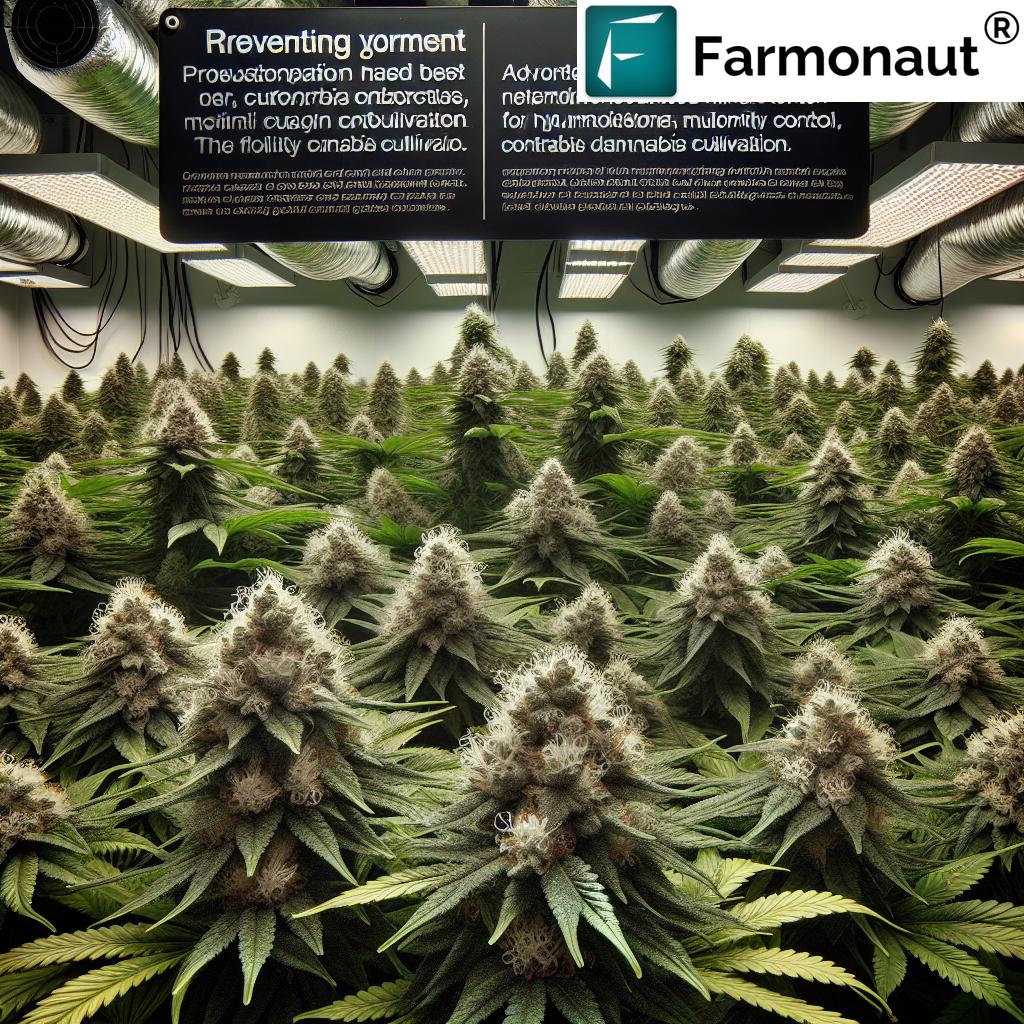Humidity During Flower: 7 Shocking Ways to Beat Mold!
“Did you know? Keeping humidity below 50% during flowering can reduce mold risk in cannabis by up to 80%!”
Humidity during the flowering stage plays a pivotal role in cannabis cultivation, directly influencing plant health, yield, and the quality of the final bud product. Too much moisture and poor humidity control can devastate even the most experienced cultivator’s crop, while proper management ensures healthy, resin-rich buds, optimal flavor, and beautiful appearance. In this comprehensive guide, we’ll take you through everything you need to understand, monitor, and master cannabis flowering stage humidity and temperature control, using scientific data, actionable strategies, and innovative technology like Farmonaut’s satellite-based insights.
Why Humidity Matters During Flowering
Humidity and temperature management are critical factors during the cannabis flowering stage. As cannabis plants progress from vegetative growth to producing dense, resinous buds, their susceptibility to diseases like mold and mildew skyrockets. Controlling humidity during the flower phase is essential for several reasons:
- Prevents Mold and Mildew: High relative humidity (RH) creates a breeding ground for harmful pathogens, especially when combined with stagnant air.
- Boosts Resin Production: Maintaining correct humidity and temperature increases trichome production, directly impacting potency and flavor.
- Optimizes Bud Quality: Proper environmental control ensures buds are dense, aromatic, and visually appealing.
- Maximizes Yield: Healthy, mold-free plants deliver the highest yield of quality cannabis.
Understanding the interaction between moisture, RH, and temperature is the first step to success in modern cannabis cultivation.
Understanding Humidity in the Flowering Stage
The Relationship Between Humidity, Moisture, and Flowering Cannabis
As flowering begins, cannabis plants transition from leafy growth to bud development. During this phase:
- The buds become denser and more susceptible to humidity and mildew in cannabis due to reduced air circulation inside flowers.
- Excessive moisture collects within and between buds, providing the perfect environment for mold or rot to start if conditions aren’t controlled.
Maintaining optimal humidity for cannabis buds is essential for disease prevention, healthy development, and maximizing final quality.
How Humidity Directly Influences Cannabis Flowering
- High RH (>60%): Increases risk of bud rot and mildew.
- Low RH (<30%): Causes plant stress, slows bud development, and can degrade resin production.
- Fluctuating RH or temperature: Destabilizes the microclimate, making plants more susceptible to pests and disease.
Through active monitoring and adjustment of environmental parameters, cultivators can mitigate these risks.
Optimal Humidity & Temperature Ranges for Each Flowering Phase
What Are the Best Conditions?
- Early Flowering (Weeks 1–4): 40%–50% RH supports rapid, healthy bud formation while preventing mold in cannabis cultivation.
- Late Flowering (Weeks 5–8+): 30%–40% RH reduces internal moisture, deterring mold, and highlighting flavor and resin.
- Best Temperature for Cannabis Flowering: 68–78°F (20–26°C) in the day, 59–70°F (15–21°C) at night.
Keeping these ranges stable, with minimal fluctuation and adequate air movement, is vital for cannabis bud rot prevention and maximizing resin production in cannabis.
“Optimal flowering temperatures between 20-26°C can increase cannabis resin production by nearly 30%.”
Risks of Improper Humidity: Mold, Mildew, and Bud Rot
Failing to maintain proper humidity during the flowering stage can lead to devastating problems, including:
-
Mold and Mildew: Both powdery mildew (white powder on leaves) and Botrytis cinerea (bud rot) thrive in high-humidity, low airflow environments.
- Buds are especially susceptible from Week 4 onward, when internal bud moisture peaks.
-
Bud Rot: Excessive moisture penetrates into dense buds, rotting the inner parts and turning them brown, gray, or mushy.
- Early detection and cannabis bud rot prevention can save part of your crop—but only if you’re monitoring humidity for cannabis daily.
- Reduced Resin & Essential Oil Production: Incorrect RH or temperatures reduce trichome (resin gland) output, decreasing potency, aroma, and the medicinal profile of the final product.
- Spread of Disease: Once established, mold and mildew spores spread easily—compromising not just your buds, but also neighboring plants.
Thus, proper environmental management is absolutely essential for every serious cannabis grower.
To enhance crop safety and prevent these risks, we recommend harnessing satellite and AI data platforms like Farmonaut for macro- and micro-level environmental monitoring.
Essential Tools for Monitoring Humidity During Flowering Stage
Precision starts with accurate data. Here’s how modern cultivators ensure humidity and temperature are always in the optimal range:
- Hygrometers: Digital or analog meters placed at canopy and bud level for tracking relative humidity in real-time.
- Thermometers: For regular temperature readings, both day and night.
- Remote Monitoring Systems: For advanced cultivators, wireless sensors upload environmental data to apps or the cloud for alerts and historical analysis.
- Satellite-Based Environmental Analysis: Platforms such as Farmonaut offer blockchain-based product traceability and verified crop health for insurance/lending—powerful tools for commercial indoor and outdoor cannabis operations.
Humidity During Flower: 7 Shocking Ways to Beat Mold!
Let’s break down the absolute best strategies every grower can implement to maintain proper humidity, prevent mold, and maximize resin production during the flowering stage:
-
1. Deploy Powerful Dehumidifiers
- Set to target RH level for the current stage (40–50% early, 30–40% late flowering).
- Empty and clean water trays daily to prevent bacterial build-up.
Pro Tip: In naturally humid regions, consider multiple units spaced evenly throughout your grow area.
-
2. Ensure Proper Ventilation for Cannabis Plants
- Install inline and oscillating fans to keep air moving across all canopy surfaces.
- Airflow should never directly blast buds—aim for turbulent, gentle movement that breaks up microclimates around dense flowers.
Farmonaut’s real-time satellite maps can spotlight areas prone to stagnant air and excessive humidity buildup.
-
3. Control Irrigation Schedules
- Overwatering is a key contributor to excess ambient moisture.
- Water early in the day, and allow several hours for substrate to dry superficially before nightfall.
Use Farmonaut’s moisture monitoring and advisory to customize your feeding schedule.
-
4. Prune and Thin Foliage Wisely
- Remove excess fan leaves within dense canopies to improve air circulation and light penetration.
- Never prune so aggressively that plants are exposed to unnecessary stress or sunburn.
Strategic defoliation enhances airflow and reduces “microclimate” humidity traps inside big buds.
-
5. Monitor and Adjust Nighttime Temperatures
- Night is when RH spikes and condensation forms.
- Maintain nighttime temps above 15°C (59°F) to keep dew point below mildew threshold.
Automated controls can further stabilize your grow—and Farmonaut’s data can help time these temperature adjustments to perfection.
-
6. Routinely Check for Mold and Mildew
- Inspect buds, stems, and underside of fan leaves daily for mold, especially after periods of high humidity or storms.
- Isolate or remove infected plant material immediately.
Early detection and fast action are critical for preventing mold in cannabis cultivation.
-
7. Employ Data-Driven Environmental Management
- Use AI and satellite analytics such as those from Farmonaut for real-time humidity and temperature mapping within indoor/outdoor setups.
- Integrate farm management apps for tracking RH, temperature, pest risk, and plant health over time.
Knowledge is power: Farmonaut’s platform, accessible via web, Android, or iOS, puts precision environmental insight in your hands, supporting automatic alerts and path correction before issues escalate.
Week-by-Week: Humidity Control & Mold Prevention Table
The ideal humidity and temperature levels vary as flowering progresses. Use this quick-reference table for humidity during flower at every stage, with tips for best practices:
| Week of Flowering | Recommended RH (%) | Ideal Temp (°C/°F) | Estimated Mold Risk | Key Tips |
|---|---|---|---|---|
| Week 1 | 50-55% | 24–26°C / 75–78°F | Medium | Boost airflow, monitor daily swings, start pruning leafy undergrowth |
| Week 2 | 48-52% | 23–25°C / 73–77°F | Medium | Maintain steady RH, increase fan speed as buds start setting |
| Week 3 | 46-50% | 22–25°C / 72–77°F | Medium | Watch for early mildew; remove lowest leaves to enhance airflow |
| Week 4 | 44-48% | 21–24°C / 70–75°F | High | Begin reducing RH, clean dehumidifiers, check for bud rot daily |
| Week 5 | 41-45% | 21–23°C / 70–73°F | High | Maximize ventilation, keep canopy dry, water only in mornings |
| Week 6 | 38-42% | 20–22°C / 68–72°F | Medium–High | Lower RH, intensify airflow, use satellite-based monitoring for micro-risks |
| Week 7 | 35-40% | 20–21°C / 68–70°F | Low | Keep humidity as low as possible, check trichomes for resin maturity |
| Week 8 (Pre-Harvest) | 30-40% | 18–20°C / 64–68°F | Low | Minimize irrigation, monitor daily for last-minute bud rot, prep for drying |
Farmonaut: Your Partner for Precision Humidity & Cannabis Flowering Stage Management
In today’s competitive cannabis market, growers need every advantage. Farmonaut is at the cutting edge of agriculture technology, providing affordable, real-time data and actionable insights for optimal growth conditions—from humidity during flower to soil moisture, disease risk, and more!
How Does Farmonaut Make Humidity Control Easier?
-
Satellite-Based Crop Health Monitoring:
- High-resolution satellite images track moisture, NDVI (vegetation health), and temperature trends across your entire field or greenhouse.
- Visualize humidity risks and microclimates before mold can take hold.
-
AI-Driven Advisory:
- Farmonaut’s Jeevn AI provides customized humidity & disease risk alerts—specific to your crop and region.
-
Blockchain Traceability:
- Integrated supply-chain tracking for cannabis and other high-value crops.
- Builds trust through transparent, tamper-proof data.
-
Fee-free API Access:
- Easy integration with your own farm management systems. Start building with the Farmonaut API and find documentation here.
-
Fleet and Resource Management:
- Streamline your cultivation operations with GPS-enabled fleet tracking, reducing downtime and optimizing maintenance.
-
Environmental Impact Monitoring:
- Track and reduce the carbon footprint of your cannabis operation via Farmonaut’s Carbon Footprinting tool to ensure sustainable cultivation practices.
Whether you cultivate a few plants or manage industrial scale operations, Farmonaut’s platform is your essential partner for precision agriculture and sustainable success.
FAQ: Humidity & Mold in Cannabis Flowering
What is the best humidity level for cannabis during flowering?
40%–50% relative humidity (RH) in early flowering, reduced to 30%–40% RH in late flowering, is widely considered optimal for cannabis flowering stage humidity management. This range prevents mold yet supports healthy, potent bud development.
Can humidity be too low during flower?
Yes—consistently low RH (below 30%) can stress plants, slow bud growth, and reduce resin production. Aim for a gradual decrease and avoid sudden changes.
What temperature should I keep during flowering?
The best temperature for cannabis flowering is 68–78°F (20–26°C) in the day and 59–70°F (15–21°C) at night. Stable temps promote healthy growth and trichome formation.
How do I know if my buds have mold or mildew?
Look for white, powdery patches (mildew) or gray/brown mushy spots inside buds (bud rot). If found, remove affected areas immediately, evaluate cause, and increase ventilation and humidity control.
Can I use just fans to control humidity?
Fans improve air circulation but don’t reduce overall humidity. Pair fans with dehumidifiers and smart irrigation scheduling for effective control.
How can Farmonaut help me with humidity and environmental risks?
Farmonaut delivers satellite-driven environmental data, real-time crop alerts, and AI-powered advisory tools to help you monitor, predict, and improve humidity and temperature management—essential for preventing mold in cannabis cultivation.
Is it possible to automate my humidity and temperature control?
Yes. Use programmable smart controllers for your dehumidifiers, heaters, fans, and irrigation—then satellite and data tools like Farmonaut for monitoring and validation.
Conclusion: Mastering Humidity for Healthy, Resin-Rich Buds
In the cannabis flowering stage, humidity control is everything. By maintaining optimal relative humidity and temperature ranges, and pairing that with modern technologies like satellite imaging and AI-driven advisories, we can consistently prevent mold, mildew, and bud rot—while optimizing resin production, yield, and overall bud quality.
- Always keep humidity within recommended stage-specific ranges, reducing it gradually as harvest nears.
- Monitor environmental conditions daily with both on-site and remote tools.
- Use dehumidifiers, ventilation systems, irrigation strategies, and smart pruning to create a healthy microclimate.
- Spot-check for early signs of disease, and act proactively to address any issues.
- Embrace precision agriculture technologies like Farmonaut to gain a data advantage at every stage of cultivation.
Want sustainable, profitable cannabis grows? Never leave your humidity and temperature management to chance—make it central to your farm, powered by actionable data and smart techniques!
For large plantations or multiple-site operations, check out Farmonaut’s Large-Scale Farm Management App for consolidated crop, weather, and environmental risk dashboards—available for both enterprise and government-grade deployments.
Ready to transform your cannabis yields and banish mold for good? Sign up for a Farmonaut subscription and take control of your farm’s success—anywhere, anytime!














